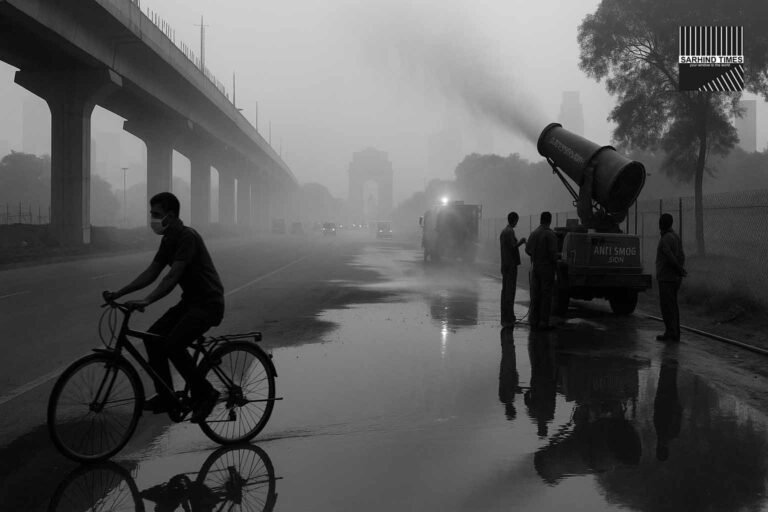By Sarhind Times Weather & Climate Desk
Mumbai, Sept 30:
The India Meteorological Department (IMD) has sounded a fresh wave of pan-India weather alerts, warning of very heavy rainfall, thunderstorms, and strong winds across several regions, even as the country transitions from the monsoon to the post-monsoon season.
The IMD’s sub-division-wise warning matrix for September 30 paints a picture of unsettled skies and heightened risks for western India in particular. Saurashtra & Kutch is on “very heavy rain” watch for today, while Konkan & Goa faces strong surface winds and a heavy rain advisory in the next 24 hours. Marathwada has been cautioned against thunderstorms, lightning, and gusty winds persisting over several days.
🚨 Key Highlights of the IMD Alert
- Saurashtra & Kutch: “Very Heavy Rain” signal for Sept 30, with moderate easing forecast over the next three days.
- Konkan & Goa: High wind speeds forecast today, followed by a heavy rain watch tomorrow.
- Marathwada: Continuous alerts for thunderstorms, lightning, and gusts, raising risks for agriculture and urban centers.
- Urban Preparedness: State and city administrations urged to pre-position pumps, trim vulnerable trees, and issue traffic advisories.
- Public Advisory: Citizens advised to avoid waterlogged stretches, swollen nullahs, and outdoor exposure during lightning events.
IMD’s Warning Dashboard: A Closer Look
The IMD’s rolling seven-day grid has emerged as a crucial planning tool for local bodies. This dashboard—divided by sub-divisions—offers a day-wise color-coded warning system:
- Red: Extremely heavy rain, life-threatening risk.
- Orange: Very heavy rain/strong storms, high risk.
- Yellow: Moderate caution, localized disruption possible.
- Green: No major warning.
For September 30, multiple yellow-to-orange warnings dominate the western seaboard. Officials say this helps state disaster response teams, municipal corporations, and power utilities in aligning emergency protocols.
Why the Alerts Matter
- Urban Flooding Risk:
With cities like Mumbai, Pune, and Ahmedabad vulnerable to clogged drains and waterlogging, IMD warnings help in pre-deployment of pumps and barricading low-lying areas. - Transport & Traffic:
Railways and highways face disruption when sudden downpours combine with strong winds. Advisory systems help mitigate road accidents and train delays. - Agriculture Impact:
For farmers in Marathwada, unseasonal thunderstorms and lightning could damage standing crops, especially cotton and soybean. Early warning allows some mitigation. - Public Safety:
Residents are repeatedly urged to stay away from swollen rivers, avoid underpasses, and minimize outdoor movement during thunderstorms.
Post-Monsoon Transition Explained
Meteorologists emphasize that late September to early October is a transition phase:
- The monsoon trough shifts southwards, altering rainfall patterns.
- Rainfall becomes patchy yet intense, often localized but capable of flooding urban pockets.
- Strong winds accompany these bursts, often uprooting trees and disrupting power lines.
Case Study: Past Lessons
- In Mumbai (2005, 2017, 2021), intense rain bursts combined with high tides to cripple the city, underscoring the importance of proactive alerts.
- Ahmedabad (2022) saw Saurashtra & Kutch flooding, where early IMD alerts allowed rapid evacuation from low-lying villages.
Expert Commentary
Senior IMD Scientist, Pune Regional Centre:
“These alerts are not meant to create panic. They are early indicators that allow civic agencies and citizens to take simple but effective precautions. The post-monsoon period is notorious for sudden weather flips.”
Urban Planner, Mumbai:
“Each IMD alert should translate into city-level micro plans—pre-positioning pumps, keeping tree-trimming squads ready, and pushing out traffic diversions in advance. Only then can alerts save lives and livelihoods.”
Preparedness on the Ground
- Municipal Bodies: Deploying de-watering pumps in flood-prone zones.
- Disaster Management Teams: Conducting mock drills and keeping boats ready in riverside districts.
- Schools & Colleges: Issuing circulars for optional holidays in red-alert districts.
- Power Utilities: Conducting preventive shutdowns in vulnerable areas.
Citizen Advisory
- Avoid parking vehicles under trees.
- Refrain from stepping into waterlogged underpasses.
- Switch off electrical appliances during lightning spells.
- Keep essential medicines, torches, and drinking water ready.
- Follow only official IMD updates and local administration orders.
Broader National Context
While the current warnings are concentrated in western India, other states also remain on watch:
- Eastern India: Pockets of Jharkhand and Odisha may see lightning activity.
- Southern India: Kerala and coastal Karnataka continue to face scattered rains.
- Northern India: Delhi and NCR may see mild drizzle, though no major warnings are in place.
Economic Impact
- Agriculture: Heavy rainfall may help recharge groundwater but threatens to damage standing crops in rain-fed belts.
- Insurance Sector: Higher claims expected from urban flooding and crop damage.
- Infrastructure: Roads, railways, and airports face repair costs after waterlogging events.
Historical Weather Trends
- September–October storms are common in Konkan & Goa, often linked to monsoon withdrawal.
- Marathwada is historically vulnerable to unseasonal lightning, causing fatalities among farmers in open fields.
- Saurashtra & Kutch have repeatedly seen very heavy rains from post-monsoon depressions moving inland from the Arabian Sea.
Conclusion
The IMD’s pan-India weather alerts serve as a reminder that even as the monsoon retreats, the risks of intense rain and thunderstorms remain real. Effective preparedness—by administrations and citizens alike—will determine how disruptive these weather events prove to be.
Until skies clear, the message remains simple: stay cautious, stay safe.
#IMD #WeatherAlert #Monsoon #IndiaWeather #StaySafe #Rain #Thunderstorm #Wind #Climate #DisasterPreparedness























+ There are no comments
Add yours